enforex_pages_destination_block_2ef4e30d-205b-4bb9-8f31-444672d71ff8
enforex_pages_course_block_8e81ab1c-3324-44fa-bfcd-9e019994bda7
STUDENT PROFILE
Our Junior program is designed for students ages 14-17 who are looking to see the world and have an unforgettable, formative experience. Our junior students not only learn Spanish language, but also culture and history thanks to our academically-excellence school network. Students also learn invaluable intercultural and interpersonal skills that will serve them well into their coming academic or professional endeavors.
BENEFITS
Our dynamic and fully-supervised program is all-inclusive: students will take Spanish classes, receive full board accommodation and engage in exciting cultural activities. Choose from four destinations in Spain and send your teens off on a once-in-a-lifetime Spanish language adventure. Watch them grow and excel as they learn Spanish and discover local Spanish culture... and then as they come home as more mature, independent and open-minded young adults! With various start dates throughout the year, students are guaranteed to love their formative and authenthic cultural immersion journey.
On On OnCozy up to Madrid this November

If you're interested in studying Spanish in Madrid with don Quijote this winter, you're in for a unique spectacle. With the cool temperatures of autumn, the city enjoys a charming transformation: the air becomes crisp, t-shirts and sandals are put away and give way to sophisticated coats and boots, many dishes, comforting and warm, and the urban vegetation is tinged with vivid reds, oranges and yellows. Apart from the typical seasonal changes, Madrid also offers fun events during this season. So take your Spanish learning experience out of the classroom and pay attention to our guide of the best things to do this November in Madrid.
Let the weather guide your stomach
Let's start with everyone's favorite topic: food! Spanish gastronomy is known for its long tradition of seasonal dishes, tapas and drinks (just try to find a person who drinks gazpacho in winter, we dare you!). The weather, so cool, is perfect for comer con cuchara (eating with a spoon) and, as Spaniards, a good, healthy cocido madrileño. The city's most famous, cocido madrileño, is cooked with garbanzo (chickpeas), vegetables and meat. Other hot and traditional dishes in Madrid are callos (yes, they're beef intestines, but trust us... they're delicious!) and garlic soup.
Another dish you must try is the famous cochinillo de Segovia. Just an hour from Madrid, the city of Segovia will surprise you with its medieval beauty and, after a great walk, you can calm your stomach with this local specialty. And if you want your gastronomic route to go one step further, why not make a reservation at Casa Botín? Recognized by the Guinness Book of Records as the oldest restaurant in the world, Casa Botín was founded in 1725 and its specialties are typically madrilenians and Castellan dishes.
And, of course, don't forget to try the churros con chocolate, which are considered part of a typical breakfast in Spain... Because there's no better way to start a cold winter day than with churros and a good cup of chocolate.
Enjoy unique gastronomic festivals
November is a month of events and festivals in Madrid, designed to satisfy all palates. If you are a jazz lover, for example, you will love the International Jazz Festival that takes place throughout the month. This festival will not only offer you more than 100 musical performances, but also jazz-related discussions, film screenings and exhibitions. On the other hand, the Madrid en Danza festival starts on November 18 and stands out for its innovative aesthetics and its commitment to international and local dance.
For foodies, there is MadrEAT, an outdoor gastronomic market where you will have at your disposal more than 20 vans specialized in gourmet food and craft beer. MadrEAT takes place in the gardens of AZCA during the third weekend of November. Finally, for those with more diverse interests, Madrid also hosts Science Week (Nov. 7-20) and Madrid Horse Week (Nov. 27-27). Never seen a horse show? Why not do it this month?
.
Get out into nature
Just because temperatures have dropped doesn't mean outdoor activities end. With the change in vegetation, areas of Madrid such as Retiro Park are transformed into a spectacular paradise of copper and golden colors. So why not take a bike or the metro and discover all the beauty of the city? In addition to the Retiro Park, you can visit others such as the Parque del Oeste, the Sabatini Gardens or the Dehesa de la Villa (former hunting ground of King Alfonso VII). The Casa de Campo is another gem: because it is the largest park in Madrid and because it houses the Parque de Atracciones and the Madrid Zoo. The park also organizes guided tours and walks.
Here it is! If you are studying Spanish in Madrid this year, don't let it go by without discovering all the beauty, culture and fun that the city has to offer!
Art and architecture in Valencia | donQuijote

If you come to learn Spanish in Valencia you’ll find our new, stunning donQuijote school waiting for you. It is a beautiful new location with 18 modern and spacious classrooms, large courtyards, terraces and gardens where you can relax between and after classes.
The school is located right in the heart of the city on Calle de Cadirers. So, besides being located in an excellent area that is well conntected with the rest of the city, the beach and beautiful parks, it is also found in the most historic part of Valencia. To give you an idea of just how historic the area is our new building was a Gothic Palace built in the 15th century and was the city's former Círculo de Bellas Arts (Fine Art Center). If its walls could talk, they would tell a thousand stories about the city, its culture, history and art!
It is an impressive, majestic building but at the same time, it is also very welcoming. You'll feel right at home while studying Spanish there... And you'll find treasures of Valencian art throughout the school! For example, if you find yourself learning Spanish with us in this beautiful school, take a good look at the stairs while you walk up to your classes. Did you know that the little column you find at the start could be the work of Pere Compte, the architect of the famous and beautiful Lonja de la seda?
Journey into Valencia's Golden Age
It’s not that far-fetched... after all the Lonja de la seda, an example of Valencian Gothic architecture, is only a three minutes' walk from the school! It’s true, as soon as you finish class you can walk to this incredible building that is as grand as a cathedral. Built between the 15th and 16th century, it was dedicated to the activity of the increasingly influential Valencian bourgeoisie. Its wide nave, its twisting columns, high ceilings and the hidden messages found in its reliefs will make you feel as if you've wandered into the bustling Valencia of the Golden Age.
Lonja de la seda
Another magnificent Valencian monument linked to our school through its architect Pere Compte, are the Torres de Quart, about seven minutes' walk from the school. These impressive towers were part of the ancient walls that defended the city in the Middle Ages. They are both high and dramatic... one can imagine a crowd of alert lookouts, running up and down their stairs, taking shelter in their protective walls, guarding Valencia!
Torres de Quart
Our school is also found about four minutes from one of Valencia's greatest monuments, the Cathedral of Santa Maria. It is the pride of the city, a cathedral built in the 13th century, which despite being a great example of Gothic architecture, includes other peculiarities, influences and add-ons from other centuries as well. And, if you didn't already know, it is said that none other than the Holy Grail is guarded within its walls. You can see this mythical relic without ever having to suffer the hardships or adventure of Indiana Jones!
Catedral de Valencia
A prosperous city filled with color
All of these magnificent works of art will give you an understanding of how rich and powerful Valencia has been for centuries. In fact, to prove it, you can travel through time, walking only four minutes from the school and visiting the Mercado Central, a Modernist building built in 1914 but still active and filled with life. We assure you it is an inspiring experience to admire the iron architecture while you do your shopping, feasting on the color and aromas of the freshest produce, meat, fish, cheese and more.
Mercado Central
Found right next to the market, but many times unnoticed, is the Church of Santos Juanes, a temple that was a mosque in the time of Al-Andalus, but which became a Gothic parish. It burned down and was reconstructed various times throughout the 14th and 16th centuries. As it stands, it is an example of many different architectural styles. It is a visual walk through the history of art!
Church of Santos Juanes
Ah! And we can't forget that just 10 minutes away, you'll find the city hall, a large Neoclassical building that is well known because every year, during las Fallas the famous mascletá, the biggest firecrackers you've ever heard, errupt in celebration in the city hall's beautiful plaza.
Valencia City Hall
There are many more things to enjoy while you're in Valencia and we could add them all to this list. But we think we’ll leave it to you to discover all of the city’s art and treasures for yourself! There's nothing like finishing class, going to any of the wonderful nearby restaurants or bars, and after having a refreshing glass of horchata, choosing a street and saying, "I'm sure there's something interesting down there", before you make your way to discover what it may be. In Valencia you're sure to be right! There are hidden treasures in this beautiful city everywhere you look.
Vineyards near Barcelona to visit this Autumn | DQ

Enjoy the best of autumn in Barcelona: the most extraordinary vineyards, exquisite wines and breathtaking landscapes in all of Catalonia.
In October autumn is officially upon us. And who doesn’t love this beautiful and refreshing season? The stifling heat of summer is finally waning, replaced by a brisk chill in the air that has us gleefully reaching for our favorite sweaters and scarves. No longer are the days of sticky sweat and ice cold showers! Gone are the bitter and contentious battles with your air-conditioning unit (because it’s either broken or running up your electricity bill)!
Autumn is the ideal season to come learn Spanish in Spain, especially in Barcelona. Along with the high temperatures, the intense crowds of tourists also dwindle, making conditions infinitely more agreeable to go out and discover this exciting city. And trust us, just because summer is over, it doesn’t mean the fun is as well! A plethora of concerts, music festivals, art expositions and other cultural events kick off in the fall months.
Of course, autumn also brings about breathtaking changes in Spain’s landscape. Rolling hills of lush green landscapes slowly transition into lovely panoramas of rustic yellows, oranges and reds. If you’re studying Spanish in Barcelona this season, it’s the perfect time to take a day or weekend trip out of the city and check out all the exquisite and colorful catalán countryside. And while you’re out there, why not take a tour of a local vineyard or get out to a wine tasting event?
Vineyards near Barcelona
It’s no secret that Spain is famous for its incredible wine, but did you know that Catalonia receives some of the most wine tourism in all of Spain? The vineyards in the region of Penedés, between Barcelona and Tarragona, are so popular in part due to their proximity to these great cities and the beautiful vistas they provide… but perhaps the most compelling factor is the cava. That’s right, this tasty sparkling wine (often known as the “champagne of Spain”), was originated in Catalonia and is primarily produced there to this day. If you haven’t tried this bubbly ambrosia yet, or are just generally a wine enthusiast, check out our recommendations for lovely vineyards near Barcelona where you can enjoy some terrific wine and cava tasting this autumn.
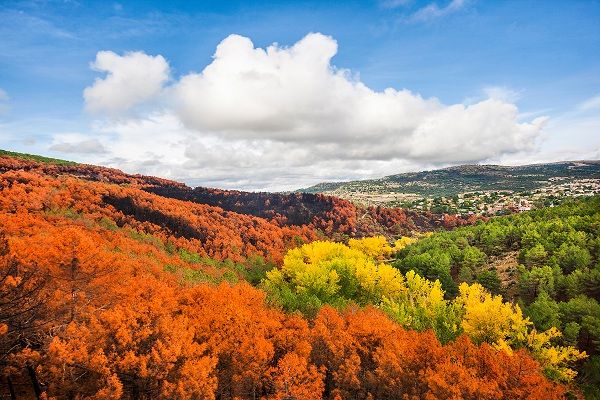
Cavas Codorníu
We’re starting with this winery as homage to cava’s origins. Codorníu is the world’s oldest producer of cava; its history dates as far back as 1551. The company continues to be the second-largest producer of this bottle-fermented sparkling wine. The breathtaking, sprawling complex was designed in 1895 and features the period’s great Catalan Art Nouveau architecture. The winery offers all types of visits and tours, including combined events where you can visit the Codorníu and also take a bicycle tour, a Simón Coll Chocolate tour or even visit the impressive Montserrat mountain. Or if you’re looking for a more laid-back experience, simply come hungry and enjoy a delicious Mediterranean breakfast or lunch on the estate.
Location: Cavas Codorniu, Avenida Jaume de Codorníu, s/n, 08770 Sant Sadurní d'Anoia
Distance from Barcelona: Approximately 45 km (40 minutes by car)
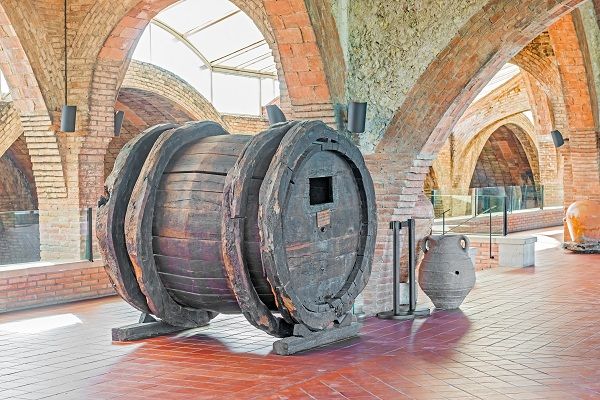
17th century wine barrel in the entrance of the Codorníu winery
Oller del Mas
Oller del Mas is a small winery that boasts of 1,000 years of history. Located within a 10th century medieval castle, this family-run winery creates a comprehensive experience for its visitors: you can do a tasting of their wines and olive oils, take a tour of the vineyards, the wine cellar and the castle, and even take a scenic ride on a mule-drawn cart! The estate also includes a restaurant and recreation area complete with swimming pool and sports such as volleyball, paddle tennis and golf. The idyllic grounds also offer breathtaking mountainous vistas, as it’s located at the foot of the Montserrat. Complete your perfect day visiting the monastery atop the Montserrat or checking out the nearby town of Manresa.
Location: Carretera de Igualada C37Z, km 91, 08241 Manresa
Distance from Barcelona: Approximately 60 km (1 hour by car)
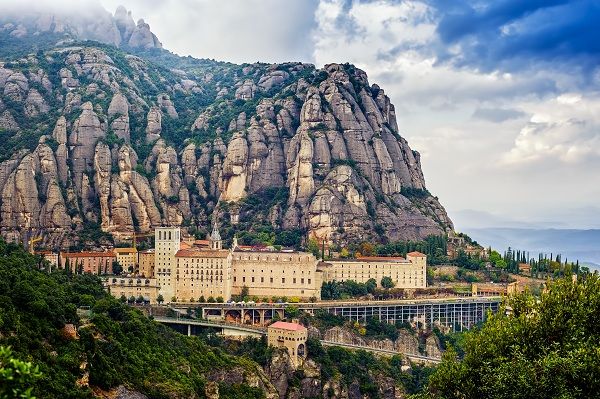
The stunning Santa Maria de Montserrat Abbey
Alta Alella
This modern, relatively young winery is located a mere 2 kilometers from the Mediterranean Sea, meaning you’ll get some stunning views of picturesque vineyards surrounded by vast blue waters. Alta Alella is known for producing some of the best cava in Catalonia, is a certified organic property. In fact, they’ve recently inaugurated their Celler de les Aus (“The Bird’s Winery”), an eco-friendly wine cellar that strives to remove the use of sulfites from the winemaking process. The winery also holds frequent events, such as seasonal wine tastings, yoga, poetry events, gourmet cooking workshop and even a wine art workshop for children!
Location: Camí Baix de Tiana, s/n, 08328 Alella
Distance from Barcelona: Approximately 22 km (40 minutes by car)
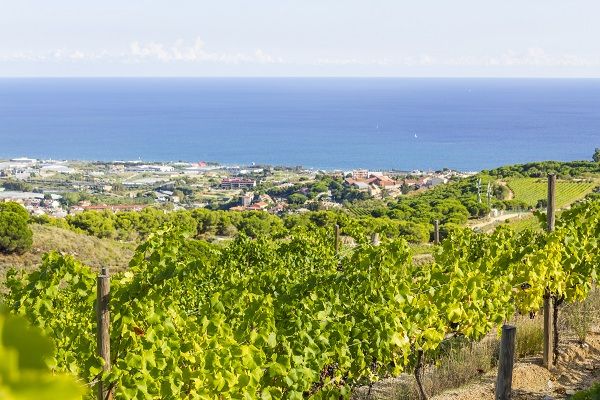
Vineyards of the Alella wine region along the Mediterranean Sea
Cavas Freixenet
This is a brand that might ring a bell; after all, this centuries-old, family-owned winery is one of the biggest producers of cava in the world! With 18 cellars throughout 7 countries, Cavas Freixenet is undoubtedly one of the biggest players in the game and a can’t-miss if you’re in Catalonia. Visiting its headquarters in Sant Sadurní d'Anoia, you’ll not only get a tasting and winery tour but a history lesson as well. Visitors first receive an audiovisual presentation of Freixenet’s history, then hop on a mini train to check out the cellars. Group and private tours are available, and they’ve even created kid-friendly visits so that the whole family can get involved!
Location: C/ Joan Sala, 2, 08770 Sant Sadurní d'Anoia
Distance from Barcelona: Approximately 45 km (40 minutes by car)
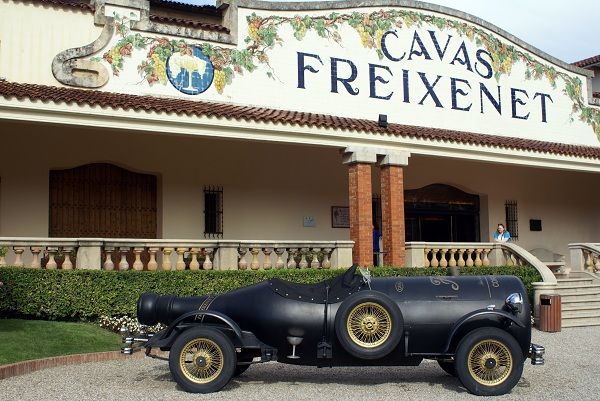
The headquarters of Cavas Freixenet in Catalonia
With all the magnificent vineyards and wineries to be discovered around Barcelona, this autumn is the perfect time to get out of the city and into its beautiful local countryside. So don’t wait, take advantage of all the magic the fall season has to offer and plan your day or weekend trip today!
Masculine or feminine? Nope. They're two different words!

One of the most curious phenomena of the Spanish language – and one that causes plenty of headaches for its students – is that our words have genders. As we know, masculine words tend to end in –o, and feminine words in –a (although there are plenty of exceptions to this rule!). Many times, the masculine or feminine character of a word is reflected by the actual gender of the person or animal; they are words that are within the same semantic category. For example chico vs. chica (boy vs. girl), toro vs. vaca (bull vs. cow) or caballo vs. yegua (horse vs. mare). However, there is another phenomenon regarding the variation of gender between words that isn't related to the masculine or feminine quality of the object. In fact, in changing the gender of the word, it actually takes on a completely different meaning. We'll give you some examples:
1. Caballo vs. caballa: yes, caballa does exist but, contrary to what you might think, it's not a female horse. A caballa is a very popular type of fish in Spain (“mackerel”).
2. Trapo vs. trapa: a trapo is a piece of fabric used for cleaning purposes (“rag”), while a trapa is a system of rigs and holds used in sailing.
3. Suelo vs. suela: the suelo is the ground or the floor, while the suela is the bottom, or sole, of a shoe.
4. Bola vs. bolo: a bola can be anything that has a spherical shape, like a ball or a scoop of ice cream, yet a bolo is what we knock down during a game of bowling (“bowling pin”)! Bolo can be easily confused with the ball used to play soccer, which is called a balón.
5. Río vs. ría: this pair is a bit more complicated. While a río is a wide current that flows into the sea or ocean (“river”), a ría is the body of water where the river meets the sea (“estuary”). For example, in Spain the rías gallegas are very famous, and beautiful.
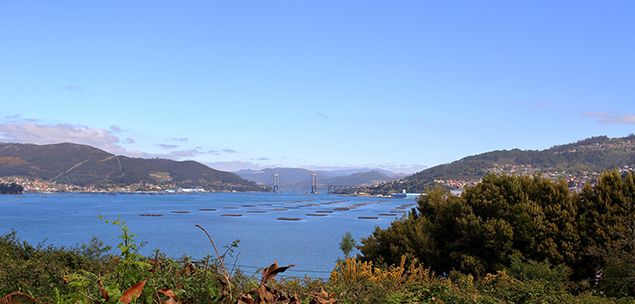
A nice example, The ría of Vigo.
6. Huerto vs. huerta: this one is tricky, even for native Spanish speakers. A huerto is a small and enclosed area of crops, like a garden; in contrast, a huerta refers to a much larger area, such as an orchard or a field. It's often the case that a huerta is comprised of various small huertos.
7. Velo vs. vela: a velo is an article of light fabric used to cover the head or face (“veil”), but a vela can be a candle or the sail of a sailboat.
8. Higo vs. higa: higo is the tasty fruit of a fig tree (“fig”). Higa is something quite different: it can be an amulet in the shape of a closed fist, often given as gifts to children, or even an offensive hand gesture.
9. Brazo vs. braza: we all know that the brazo is the arm; a braza, however, is a measure of length used for water depth (the equivalent of about 6 feet), known as a fathom.
10. Bando vs. banda: while a bando is any type of proclamation or public announcement, a banda can have various meanings such as: a group of people (including, yes, a musical band), a type of belt or sash, or one of the longer sides of a sports field.
There you have it, more proof of how curious Spanish vocabulary can be. There are always surprises and new meanings to be discovered! By the way, do you know of any other examples?
How to survive August in Spain | donQuijote

We’re bringing you everything you need to know about how to survive the heat and the crowds this August.
If you are learning Spanish in Spain this summer, it's important that you know how to make the most of the month of August. Some Spaniards take a whole month of vacation, pack their bags and take off to the beach. Regardless of age or social status, there are many who engage in this “summer migration”: there are the employed taking their well-deserved vacation days, the retired looking to get a change of scenery, and of course the students who so eagerly look forward to their summer vacation. Understandably, for foreigners who come to Spain, it can be a bit strange to find some cities emptier and quieter than usual or their towns suddenly saturated with Spaniards that usually do not live there but that are spending their vacation there, just like any other tourist.
But that's not to say all Spaniards engage in this August vacation custom. Many won't take a whole month off, especially those who work for a private company; many others take their vacations in June or July, and others prefer to have a "staycation" in their cities and simply opt for small trips to the beach or the mountains. It all depends on the individul company or professional sector in which a person works. There are no hard or fast rules about vacation in Spain, but what we can do to help our students is highlight some cultural trends and provide tips on how to survive (and have the best ever) August in Spain.
Get creative and get talking
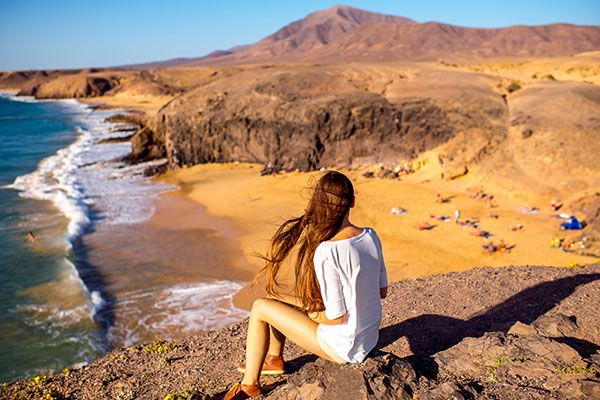
No doubt that while you’re staying in Spain, you'd like to plan your activities and trips to avoid running into too many crowds. Want some advice? When planning, don't just stick to the typical places, get creative! Of course we all want to hit the beach over the summer, but keep in mind that some parts of the coast are filled-to-the-brim with tourists and Spaniards alike in August. Best to choose other lesser-known spots to have a beach getaway; for example, the Cala La Rostella is a great choice if you're in Barcelona on the Costa Brava, or Maro if you are in Malaga.
When you're not away on your own weekend trips, you can always cool off with a drink on a terrace, in a park or municipal swimming pool, all places where you're sure to meet local Spaniards who can help you discover other interesting or exclusive spots. So, our other piece of advice is to get talking! Not only is it the perfect way to practice your Spanish, you’ll also find out about those “best kept secrets” spots! For those in Madrid, for example, did you know that the Universidad Autónoma has a pool just for adults? The only requirement to either be a current or previous college student (any student ID or a copy of a diploma should do the trick). Sure, it’ll still be crowded, but at least you’ll avoid the overwhelming congestion of the public pools – and the screaming kids.
Keep cool like a local
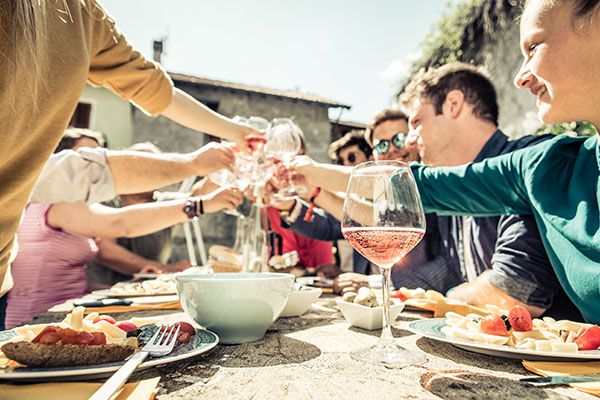
Spaniards have their own tricks to beat the heat during the very hot and super fun month of August. For example, the famous siesta that everyone now associates with a nap, actually has less to do with sleeping and more to do with avoiding the hours when the sun is at its strongest. But that doesn't mean you have to stay at home during the midday closure hours! There are plenty of cool ideas for this time of day, such as visiting a museum, going to movies, or even checking out one of the many shopping malls Spain's cities are saturated with... why not take advantage of the August rebajas or sales and update your wardrobe? You'll be glad to be taking advantage of the central air conditioning as well!
Another local trick to keep the August heat at bay is to choose the type of food and drink for your meals wisely. For example, a Spaniard wouldn't be caught dead eating a hot potaje or estofado during the hotter months. Instead they’ll opt for cold soups like gazpacho or salmorejo, and cooling tapas like boquerones en vinagre or ensaladilla rusa. And to wash it all down, Spaniards sometimes opt for their curious alcohol-mixed-with-soda concoctions: a clara, for example, is a beer mixed with lemon Fanta; tinto de verano recipes can vary but generally include red wine, a lemon-lime soda or seltzer and fruits; the refreshing and light rebujitos, very popular in Andalusia, are often some combination of sherry or white wine and Sprite or a lemon-flavored soda. All, of course, served very, very cold.
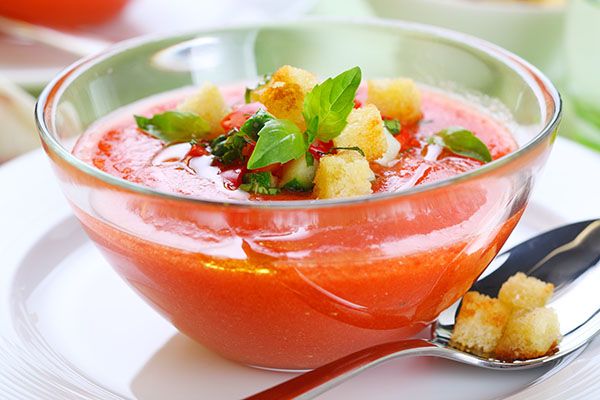
If you are studying in Spain this summer, and specifically in August, you'll no doubt enjoy the incredible variety of local activities and events that all Spanish cities have to offer. Most of these activities are out in the streets, where summer is truly lived and loved. But if you ever get too hot, remember that you can always escape to the beach to discover some special, unique spot guaranteed to keep you cool and content. However you choose to live your August, we're positive you will enjoy every minute of your experience in Spain. So get out there! What are you waiting for?
Summer Cinema in Spain | don Quijote's blog

Summer cinema in Spain has always had a certain element of sentimentality. For many, attending outdoor movies is more an excuse to enjoy a warm summer night than anything else; in fact, it's safe to say that for many Spaniards, their earliest memories are wrapped up in the nostalgia of a summer night spent outside at the park in front of a movie screen.
Summer Cinema's Small Town Origins
These days, outdoor cinemas have become a widespread, popular entertainment option, but there was a time when these kinds of movie theaters were considered "provincial." Until relatively recently (we're talking some 40 years ago) many small towns only had access to movies via traveling companies that would come to town for a few days and install portable film projectors and screens in the towns’ main squares.
According to history books, these outdoor summer cinemas became popular because during this time, indoor movie theaters didn’t have air-conditioning. Movie-goers preferred to watch films outdoors because cool summer evenings were more pleasant than stuffy theaters; but with the advent of air-conditioned theaters the public once again returned to indoor cinemas.
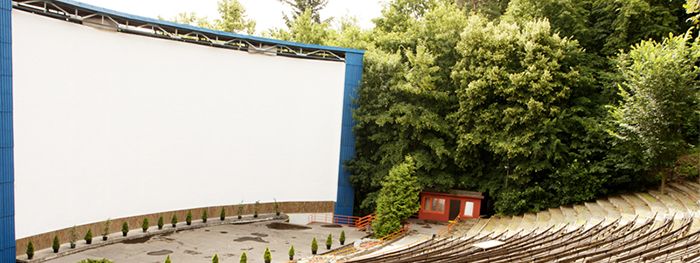
Coming Back into Fashion
In recent years, whether for nostalgic or economic reasons, open-air cinemas have come back into fashion, and are now more popular and include more variety than ever. There are outdoor theaters that are set up practically like a conventional auditoriums with all the comforts included (like the outdoor cinema in Seville); others that are a little more bare-bones and require attendees to bring their own seats and snacks (like those on the beach in Valencia)... and there are even cinemas that play musicals and let the audience sing along! (Such as the "Sing Along" events organized in various cities in Spain).
Going to an outdoor cinema this summer is a great way to unwind after an afternoon of study: prices are usually very reasonable and you'll even be able to continue your language learning because almost all of them include films dubbed into Spanish.
What You Can See at Your Destination in Spain
Summer Cinema in Madrid
If you're in Madrid there are several outdoor cinema options: the Conde Duque Cultural Center (Calle Conde Duque, 9) organizes themed sessions with prices ranging from €5 to €8. Parque de la Bombilla (Plaza de San Antonio de la Florida, 1) has been organizing its famous double sessions for all types of audiences for decades; and it is also the place where you’ll find the best prices, just €4 for a double feature. If you're looking for something a little more alternative check out La Casa Encendida to enjoy a great rooftop terrace and interesting films for just €3. And if you don't feel like spending a penny on your outdoor theater experience check out Parque El Paraíso in San Blas (Avenida de Arcentales).
Summer Cinema in Salamanca
Salamanca is once again hosting its outdoor film festival, "Biblioteca: Gran Pantalla" (Big Screen Library) at the Torrente Ballester Library (Paso de los Olivos, 10) with programming focused on the adventures of famous mischievous, or nonconformist literary characters like Oliver Twist, Billy Elliot, Tom Sawyer and Peter Pan. What better way is there to spend an afternoon than with old friends who never grow old? And without paying a penny!
Summer Cinema in Seville
The heat in Seville is a way of life. So, how could they not have outdoor summer cinema? Each district has at least one; the district of Alcosa-Este-Torreblanca has three, and at least one that's "nomadic," meaning it changes location, like to the Sur or Macarena districts. Finding these screenings can be a little difficult, but it's worth the search if you want to see some great cinema for free. Another good option for an outdoor flick is the Patio de la Diputación de Sevilla (Av. Menendez Pelayo, 32) and their "Asómate the Patio" initiative, where you can see prestigious, award-winning films for only €4.
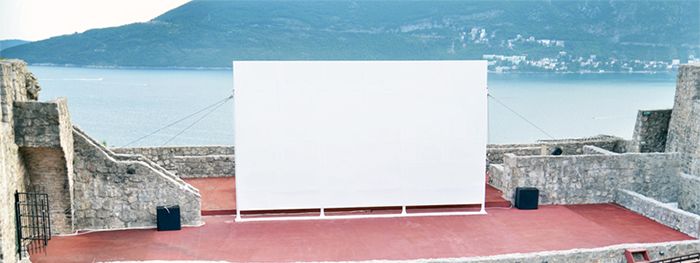
Summer Cinema in Granada
If you're in beautiful Granada this summer and you love superhero movies, don't miss out on those shown at CineMa Plaza (Plaza de las Culturas, Avenida de la Ciencia, 2). They show a wide variety of movies from some of the newest releases, like Deadpool, to modern classics like 300 and Watchmen, to legendary titles like Conan the Barbarian; and they are all free. If you're more of an arthouse fan, check out the "Cine al fresquito," a film festival located at the Caves of Sacromonte Museum (Barranco de los Negros) for just €3.50.
Summer Cinema in Barcelona
Barcelona is another city with an incredible range of outdoor cinemas to experience, and they are practically organized by theme. At Poble Espanyol (Avenida Francesc Ferrer i Guardia, 13) you can find classic musicals like Grease, Dirty Dancing, Mamma Mia and Moulin Rouge; at Fossar de Santa Eulalia (Carretera de Montjuïc, 66) you can enjoy independent movies like Whiplash, Pride or Birdman as well as classics like Casablanca and Silence of the Lambs; and at the Center for Contemporary Culture of Barcelona (Carrer de Montalegre, 5) you'll be surprised by avant-garde and experimental films like Labyrinth of Passion, Don't Look Now and The Babadook.
These are all just a few examples of some of the outdoor theaters you can find in some of our biggest cities, but there are many more to explore. Wherever you find yourself in Spain, we're sure you'll find a great place to watch a great movie under the stars in the cool summer breeze!